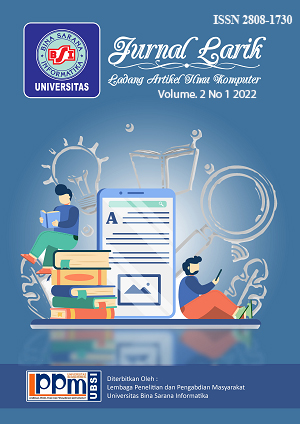Klasifikasi Data Penjualan Mengunakan Algoritma K-Means Dan Analytic Hierarchy Process
DOI:
https://doi.org/10.31294/larik.v2i1.1371Keywords:
K-Mean, AHP, DATA MININGAbstract
With the Covid 19 which has hit the last few years, sales in various fields have a negative impact, including Supermarket X, which has experienced a decline in various branches in various regions. For consideration, they evaluate the sales of these branches. By classifying the existing sales data, it is hoped that they will be able to see which self-service branch group x is not doing well, which one is already good. However, it is necessary to have a good classification technique so that evaluations are carried out based on good calculation results. Therefore, the author tries to use the K-Mean Algorithm and the AHP Algorithm to classify the existing sales data. The K-Mean Algorithm and the AHP Algorithm are algorithms that are able to cluster a set of data. By clustering the stores based on the proximity of the sales results for the last 2 years which has gone up and down using these 2 algorithms, we will be able to see which stores are classified as good and which are not. Based on the comparison results from the calculation results, it was found that the best results were using the K-Mean algorithm with k2 in the 3rd literacy with a ratio of 0.04926
References
Butsianto and N. T. Mayangwulan, “Penerapan Data Mining Untuk Prediksi Penjualan Mobil Menggunakan Metode K-Means Clustering,” J. Nas. Komputasi dan Teknol. Inf., vol. 3, no. 3, pp. 187–201, 2020, doi: 10.32672/jnkti.v3i3.2428
Nuryaman, Y.(2017). "Komparasi Algoritma Kmean dan Ahc untuk Klasifikasi Curah Hujan di Indonesia." Ikraith Informatika, vol. 2, no. 2, 1 Jul. 2018, pp. 70-75.
Normah, N., Nurajizah, S., & Salbinda, A. (2021). Penerapan Data Mining Metode K-Means Clustering untuk Analisa Penjualan Pada Toko Fashion Hijab Banten. JITK AMIK BSI, 22(2)
Yulianti, Y., Utami, D. Y., Hikmah, N., & Hasan, F. N. (2019). Penerapan Data Mining Menggunakan Algoritma K-Means Untuk Mengetahui Minat Customer Di Toko Hijab. Jurnal Pilar Nusa Mandiri, 15(2), 241–246. https://doi.org/10.33480/pilar.v15i2.650
G. Gustientiedina, M. H. Adiya, and Y. Desnelita, “Penerapan Algoritma K-Means Untuk Clustering Data Obat-Obatan,” J. Nas. Teknol. dan Sist. Inf., vol. 5, no. 1, pp. 17–24, 2019, doi: 10.25077/teknosi.v5i1.2019.17-24.
I. Parlina, A. P. Memanfaatkan Algoritma K-Means Dalam Menentukan Pegawai Yang Layak Mengikuti Asessment Center. Journal of Computer Engineering, System and Science, 2018; 3(1): 87-93.
Siregar, M. H. (2018). Data Mining Klasterisasi Penjualan Alat-Alat Bangunan Menggunakan Metode K-Means (Studi Kasus Di Toko Adi Bangunan). Jurnal Teknologi Dan Open Source, 1(2), 83–91. https://doi.org/10.36378/jtos.v1i2.24
Armaita, Dedi , H., Eri , B., Indang , D., & Iswandi, U. (2020). Policy Model of Community Adaptation using AHP in the Malaria Endemic Region of Lahat Regency -Indonesia. International Journal of Management and Humanities (IJMH), 44-48.
Deny , S., Agus , R., & Yushar , K. (2020). ANALISIS PENENTUAN TIPE FONDASI PILAR JEMBATAN DENGAN MENGGUNAKAN METODE ANALYTICAL HIERARCHY PROCESS (AHP) (Studi Kasus: Pembangunan Jembatan Walahar Kecamatan Ciampel, Kabupaten Karawang)
Armaita, Dedi , H., Eri , B., Indang , D., & Iswandi, U. (2020). Policy Model of Community Adaptation using AHP in the Malaria Endemic Region of Lahat Regency -Indonesia. International Journal of Management and Humanities (IJMH), 44-48
Downloads
Published
Versions
- 2022-07-30 (2)
- 2022-07-30 (1)




